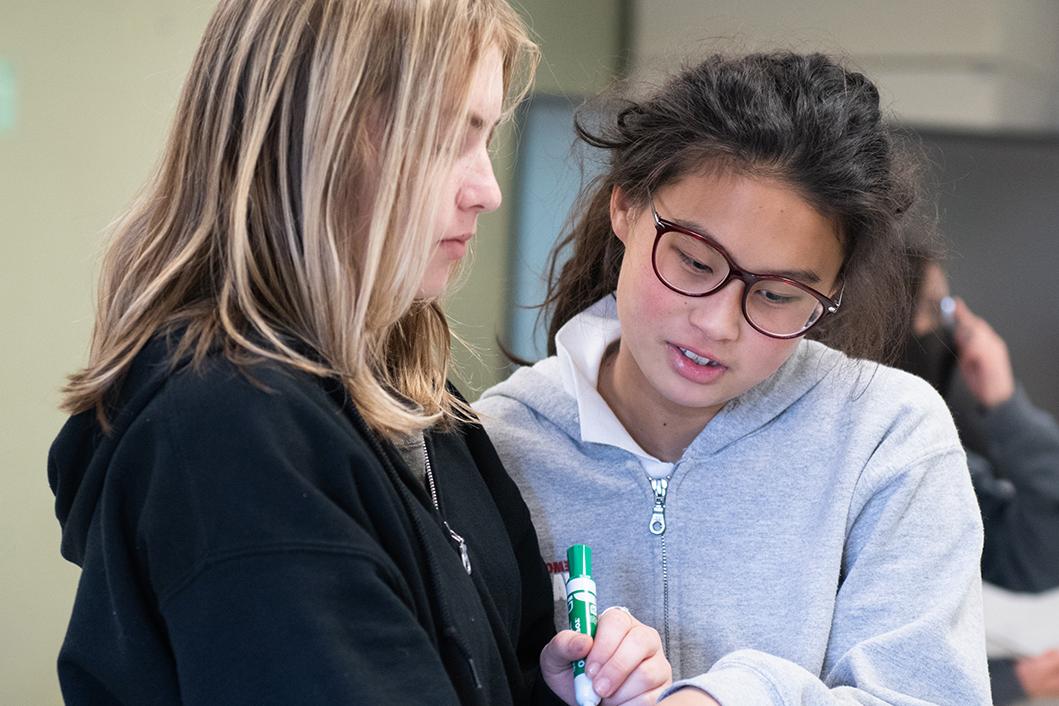Step into our elementary school, where learning becomes an adventure grounded in faith and excellence. At Fremont Christian, we believe that a Christian education not only provides academic advantages but also fosters holistic development, ensuring that every child thrives emotionally, intellectually, and spiritually. Our dedicated teachers create dynamic learning experiences that ignite curiosity and inspire a love for knowledge. Rooted in our Christian identity, we empower students to navigate the world with integrity and purpose, equipping them with values that transcend the classroom. We recognize the importance of parental involvement and warmly welcome parents to engage in community-building events, forging connections that strengthen the educational journey of each child. The habits and skills developed in elementary lead to 97% of our high school students being UC eligible, compared to 51.7% of high school seniors statewide. (Source: The Orange County Register)

Elementary Curriculum Overview
FCS has adopted a math program based on Common Core State Standards (CCSS), which focuses on depth rather than breadth, building conceptual foundations, and, most importantly, engagement in the process and application of math concepts. Designed to reflect the way children learn mathematics, Math Expressions (Houghton Mifflin Harcourt) provides a solid conceptual base grounded in more than 20 years of research. Students are expected to problem-solve, explain their thinking, and prove their answers. Each unit begins with an inquiry-based activity to activate thinking, access prior knowledge, and address preconceptions. Foundational to our mathematics instruction is the understanding that there are multiple paths to solving a problem. Providing a math learning environment that goes beyond memorization, rote learning, and basic computation allows students to learn with understanding, which then leads to transference and the ability to apply learning in new situations.
The FCS English language arts (ELA) curriculum reflects a workshop framework: students reading and writing across genres, making textual connections, and communicating those ideas in various ways. Students read at their independent reading levels and engage in guided reading at their instructional level. They are expected to respond orally and in writing to the texts they read. This framework provides students with instruction in the many genres of texts, strategies for metacognition, and opportunities to practice these skills. Students set personal goals for becoming better readers and writers, which they work toward through extensive and close reading, guided reading, conferring and daily writing. This approach emphasizes skill development (phonics, comprehension, text structures, etc.) with a particular focus on vocabulary development (the greatest predictor of academic achievement) and learning the language of workshop.
Word study and grammar help students recognize patterns in the English language to inform their reading and writing. Unlike the traditional spelling test, word study focuses on identifying the spelling and meaning patterns in the English language to learn how to spell and infer meaning of words so that students can transfer this knowledge to previously unknown and unseen words. Grammar is taught within context so that students learn to recognize how grammar changes meaning.
The California CCSS language standards require students to learn to print legibly, and beginning in grade three, write legibly in cursive. We use a D’Nealian handwriting program (Scott Foresman) that begins with printing and, in later grades, progresses naturally into cursive. Even in this age of technology, it is important for individuals to be able to handwrite legibly. Dr. William Klemm (2013), a professor of neuroscience at Texas A & M University, describes the many developmental and psychological benefits of learning cursive, including sensory-motor coordination, cognitive demand which benefits thinking processes, the engagement of both hemispheres of the brain, and developing tactics for learning in general.
Social Studies & Science
Published by UpLevel, our social studies and science curricula are California standards and Next Gen standards-based with Project GLAD strategies embedded. CCSS ELA standards play an integral part in the instruction. Of key importance in the UpLevel curriculum is that students learn how to learn, their learning capacity is increased, and they are able to comprehend new ideas and concepts more quickly. All elementary students receive the weekly magazine TIME for Kids, which teachers use to discuss current events and further extend social studies learning. Field trips, projects, labs, engineering kits, STEAM nights, and other media and materials provide enrichment for these content areas.
Bible Studies
The transitional kindergarten Bible program is focused on character building through Old and New Testament stories and learning scripture. Kindergarten through fifth grade follow the Building on the Rock (Summit Ministries) program, which focuses not only on character development but on understanding the foundations of a Christian worldview through the building of the House of Truth. The content of the curriculum affirms the metanarrative of Scripture: (1) God created all things good. At creation, all things were in harmony. (2) At the Fall (Genesis 3), the whole created order fell into disharmony due to the disobedience of man. (3) In the person of Jesus Christ, God began the process of redemption and renewal. (4) In the end, God will restore all things through his Son Jesus Christ.
We believe the biblical metanarrative is manifested in four key relationships of creation. (1) Fellowship: The relationship between God and man. God created man for relationship with Himself; that relationship was broken because of sin; that relationship is restored through Jesus Christ. (2) Image-bearers: Man was created as whole and healthy being, as an imagebearer of God; sin brought disharmony and conflict into the life and heart of man. Redemption through Jesus Christ begins the healing process within man. (3) Servanthood: God created man for harmonious and loving relationships with other people; sin is the cause of disharmony and discord among people; part of restoring mission of Jesus Christ is to bring people back into harmonious relationship with one another. (4) Stewardship: God placed the whole created order under the rule and care of His image-bearers (Genesis 1); with the Fall, the relationship between man and the rest of the created order was marred; In Jesus Christ, God continues to call His image-bearers to work to preserve and protect the created order.
In the interest of developing the whole child, all students receive twice-weekly instruction in both music (Kodály Method) and physical education. Chromebook carts are provided for every grade level and are used to integrate web-based applications into the teaching and learning both in classrooms and at home. In third grade, students learn to play the recorder. Students may then opt to participate in either symphonic band or handbells beginning in the fourth grade, in addition to classroom music. All students in fourth and fifth grades learn to sing chorally and perform at different events during the year.
Schedule a Tour
Call 510.744.2241 or submit an Information Request form.
Apply Today
Create an account & begin your child's application online.








